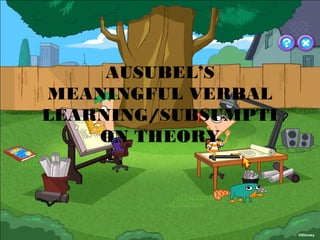
Ausubel's Meaningful Learning Theory and Advance Organizers
- 2. DAVID PAUL AUSUBEL • Born in 1918 and grew up in Brooklyn, New York. • He attended University of Pennsylvania majoring in Psychology for pre-med. • He earned a Ph. D in Developmental Psychology from Columbia University • His most significant contribution was on the development and research on advance organizer.
- 4. Focus of Ausubel’s Theory Important factors influencing learning Quantity Clarity Organization of the learner’s present knowledge
- 6. Meaningful learning takes place when an idea to be learned is related to some sensible way to ideas that the learner already possesses. Before new material can be presented effectively, the student’s cognitive structure must be strengthened. Advance Organizers - the way to strengthened student’s cognitive structure. - allow students to already have a bird’s eye view or to see the big picture of the topic
- 7. A process by which new material is related to relevant ideas in the existing cognitive ADVANCE ORGANIZERS SUBSUMPTION
- 8. 4 PROCESSES FOR MEANINGFUL LEARNING DERIVATIVE SUBSUMPTION CORRELATIVE SUBSUMPTION SUPERORDINATE LEARNING COMBINATORIAL LEARNING
- 9. DERIVATIVE SUBSUMPTION This describes the situation in which the new information you learn is an example of a concept that you have already learned. Example: Let’s you have acquired a basic concept such as “bird” . You know that a bird has feathers, beak and lays egg. Now you learn about a kind of bird that you have never seen before, let’s
- 10. CORRELATIVE SUBSUMPTION It enriches the higher-level concept. Example: You see a new kind of bird that has a really big body and long strong legs. It doesn’t fly but it can run fast. You may now include your concept of an ostrich to your previous concept of what a bird is.
- 11. SUPERORDINATE LEARNING You already knew a lot of examples of the concept but did not know the concept itself until it was taught. Example: A child was well acquainted with banana, mango, guava, etc. but the child did not know, until she was taught, that these were all examples of fruits.
- 12. COMBINATORIAL LEARNING This is when newly acquired knowledge combines with prior knowledge to enrich the understanding of both concepts. Example: To teach someone about how plants “breathe” you might relate it to previously acquired knowledge of human respiration where man inhales oxygen and exhales carbon
- 13. ADVANCE ORGANIZER A major instructional tool proposed by David P. Ausubel. TWO BENEFITS You will find it easier to connect new information with what you already know about the topic You can readily see how concepts in a certain topic are related to each other
- 14. TYPES OF ADVANCE ORGANIZERS EXPOSITORY describes the new content. NARRATIVE presents the new information in the form of a story to students. SKIMMING is done by looking over the new material to gain a basic overview. GRAPHIC ORGANIZER visuals to set up or outline the ne information. This may include pictographs, descriptive patterns, concept patterns and concept maps.
- 15. •
- 19. APPLICATION OF PRINCIPLES The most general ideas of a subject should be presented first and then progressively differentiated in terms of detail and specificity. He called this progressive differentiation. The purpose of progressive differentiation is to increase the stability and clarity of anchoring ideas. Instructional materials should attempt to integrate new material with previously presented information through comparisons
- 20. Reference -FLCT book Prepared by : Dawn Jovie O. Gumanit BEED-1